

Compact Muon Solenoid
LHC, CERN
| CMS-PAS-EXO-21-009 | ||
| Search for new physics in the τ plus missing transverse momentum final state in proton-proton collisions at √s= 13 TeV | ||
| CMS Collaboration | ||
| July 2022 | ||
| Abstract: A search for physics beyond the standard model (SM) in the final state with a hadronically decaying τ lepton and neutrino is presented. This analysis is based on data recorded by the CMS experiment from proton-proton collisions at a center-of-mass energy of 13 TeV at the LHC, corresponding to a total integrated luminosity of 138 fb−1. No significant deviation from the SM prediction is observed. Model independent limits are set on the production cross section of W' bosons decaying into τ lepton plus neutrino final states. Lower limits are set on the mass of the sequential SM-like heavy charged vector boson and the mass of a quantum black hole. Upper limits are placed on the couplings of the new resonance with the SM fermions. Limits are additionally set on non-universal gauge interaction models and an effective field theory model. Upper limits on the cross section of t-channel leptoquark exchange are presented and are translated into exclusion limits on the mass and coupling of leptoquarks; the sensitivity of this analysis reaches into the parameter space of leptoquark models that could explain the anomalies measured in B-meson decays. The limits presented are the most stringent to date. | ||
|
Links:
CDS record (PDF) ;
CADI line (restricted) ;
These preliminary results are superseded in this paper, Submitted to JHEP. The superseded preliminary plots can be found here. |
||
| Figures | |
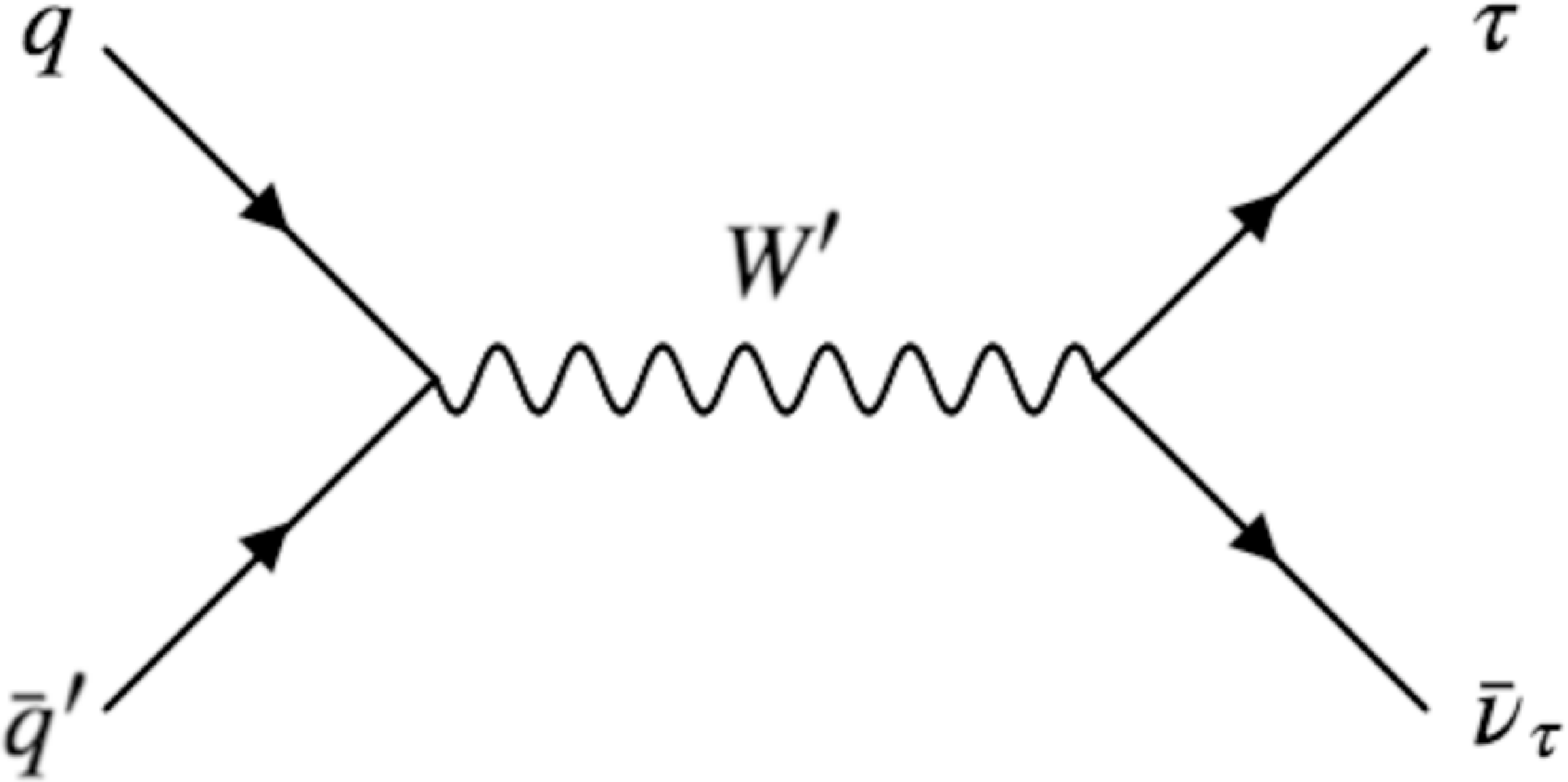
png pdf |
Figure 1:
Leading order Feynman diagram for the production and decay of a new heavy charged vector boson, W' boson decaying to τν. |
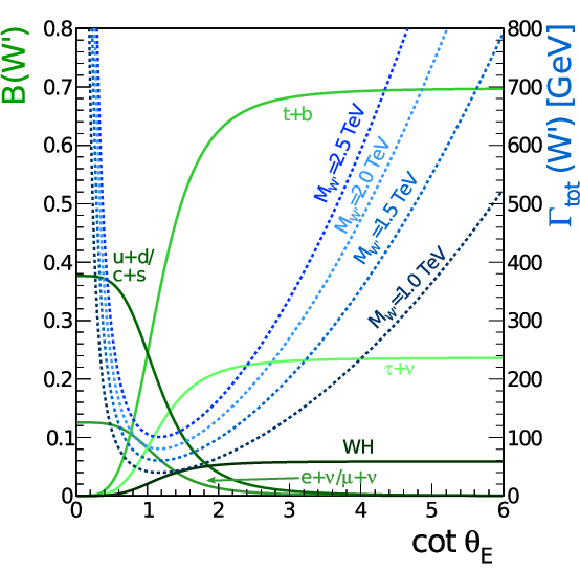
png pdf |
Figure 2:
Branching fractions B(W′) as a function of the mixing angle cotθE, for W' boson decays in the NUGIM G(221) framework, as calculated in Refs. [7,8,9]. Total decay, Γtot, widths can also be determined as a function of the mixing angle. When re-scaled to accommodate the WH decay channel, the values associated with cotθE= 1 correspond to those in the SSM. |
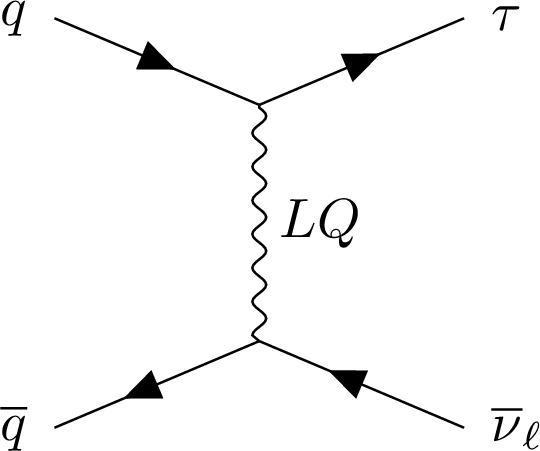
png pdf |
Figure 3:
Leading-order Feynman diagram of the process pp→τν mediated via an LQ in the t-channel. |
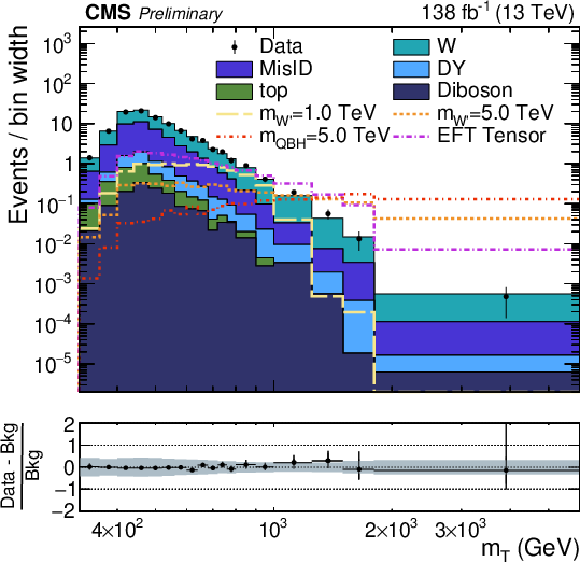
png pdf |
Figure 4:
The transverse mass distribution of τ leptons and missing transverse momentum observed in the Run-2 data (black dots with statistical uncertainty) as well as the expectation from SM processes (stacked histograms). The ratios of the background subtracted data yields to the expected background yields are presented in the lower panel. The combined statistical and systematic uncertainties in the background are represented by the grey shaded band in the ratio panel. |
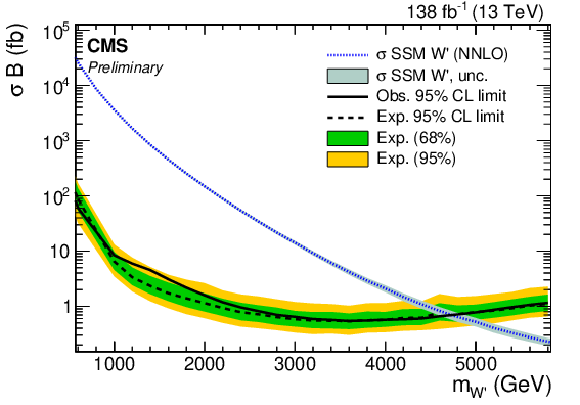
png pdf |
Figure 5:
Bayesian upper exclusion limits at 95% CL on the product of the cross section and branching fraction of a W' boson decaying to a τ lepton and neutrino in the SSM model. For this model, W' boson masses of up to 4.6 TeV can be excluded. The limit is given by the intersection of the observed (solid) limit and the theory cross section (dotted-blue) curve. The 68 and 95% quantiles of the limits are represented by the green and yellow bands, respectively. The σB for an SSM W' boson, along with its associated uncertainty, calculated at NNLO precision in QCD is shown. |
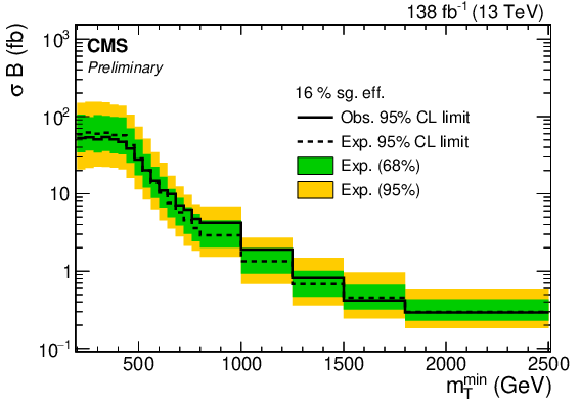
png pdf |
Figure 6:
Bayesian 95% CL model independent limit for a back-to-back τ lepton plus pTmiss topology. To calculate this limit, all events for signal, background, and data are summed starting from a minimum mT threshold and then divided by the total number of events. No assumption on signal shape is included in this limit. The expected (dashed line) and observed (solid line) limits are shown as well as the 68% and 95% CL uncertainty bands (green and yellow, respectively). |
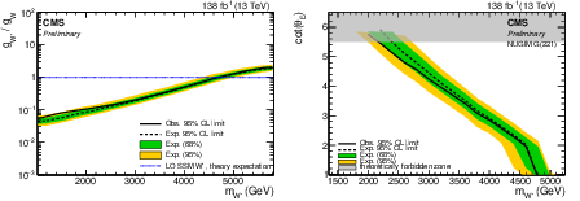
png pdf |
Figure 7:
Bayesian upper exclusion limits on the product of production cross section and branching fraction for different coupling strengths for an SSM-like W' boson with respect to SM-like couplings. In the left plot, upper limits on the ratio gW′/gW are shown. The unity coupling ratio (dotted blue curve) corresponds to the SSM common benchmark. In the right plot, the lower exclusion limits on the NUGIM G(221) mixing angle (right) cot(θE) are shown as a function of the W' boson mass. The theoretically excluded region is shaded in grey. The 68 and 95% quantiles of the limits are represented by the green and yellow bands, respectively for both plots. |
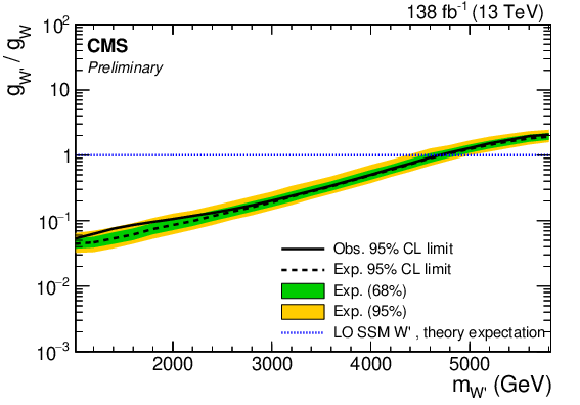
png pdf |
Figure 7-a:
Bayesian upper exclusion limits on the product of production cross section and branching fraction for different coupling strengths for an SSM-like W' boson with respect to SM-like couplings. In the left plot, upper limits on the ratio gW′/gW are shown. The unity coupling ratio (dotted blue curve) corresponds to the SSM common benchmark. In the right plot, the lower exclusion limits on the NUGIM G(221) mixing angle (right) cot(θE) are shown as a function of the W' boson mass. The theoretically excluded region is shaded in grey. The 68 and 95% quantiles of the limits are represented by the green and yellow bands, respectively for both plots. |
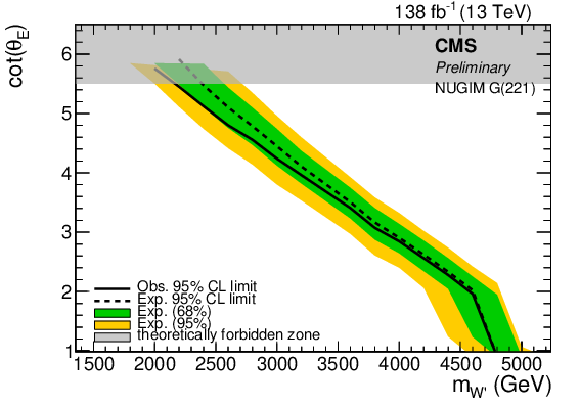
png pdf |
Figure 7-b:
Bayesian upper exclusion limits on the product of production cross section and branching fraction for different coupling strengths for an SSM-like W' boson with respect to SM-like couplings. In the left plot, upper limits on the ratio gW′/gW are shown. The unity coupling ratio (dotted blue curve) corresponds to the SSM common benchmark. In the right plot, the lower exclusion limits on the NUGIM G(221) mixing angle (right) cot(θE) are shown as a function of the W' boson mass. The theoretically excluded region is shaded in grey. The 68 and 95% quantiles of the limits are represented by the green and yellow bands, respectively for both plots. |
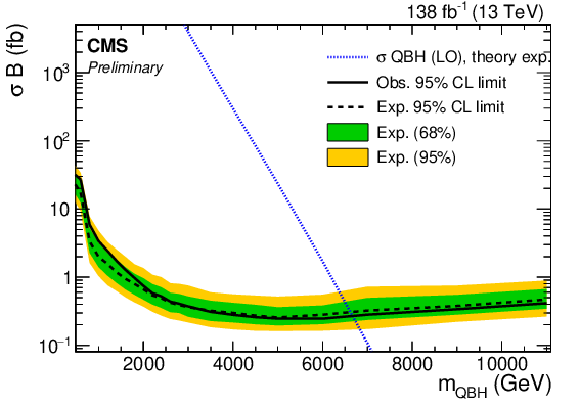
png pdf |
Figure 8:
Bayesian upper exclusion limits at 95% CL on the product of the production cross section and branching fraction of a QBH in an associated τ lepton and neutrino final state. Masses of up to 6.6 TeV are excluded. The observed limit (solid line) is obtained from the intersection with the LO QBH cross section (dotted-blue curve). The 68 and 95% quantiles of the limits are represented by the green and yellow bands, respectively. |
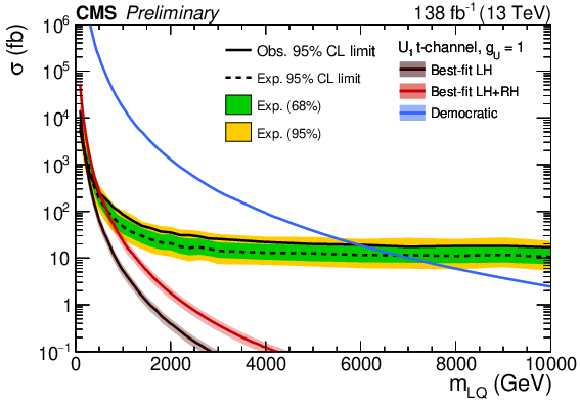
png pdf |
Figure 9:
Bayesian upper limits at 95% CL on the cross section of the process pp→τν mediated via LQ exchange in the t-channel. The inner (green) band and the outer (yellow) band indicate the regions containing 68 and 95%, respectively, of the distribution of limits expected under the background-only hypothesis. The predicted LQ cross section at LO in the three coupling benchmark scenarios is depicted in different colors for gU= 1. The first benchmark scenario considers only couplings to left-handed SM fermions (i.e. βijR= 0) and is referred to as ''best-fit LH''. The second benchmark, referred to as ''best-fit LH+RH'', considers |βbτR|= 1 and all other βijR= 0. In the third ''democratic'' benchmark, equal couplings only to left-handed fermions are assumed, i.e. |βijL|= 1 and βijR= 0 for all i and j. |
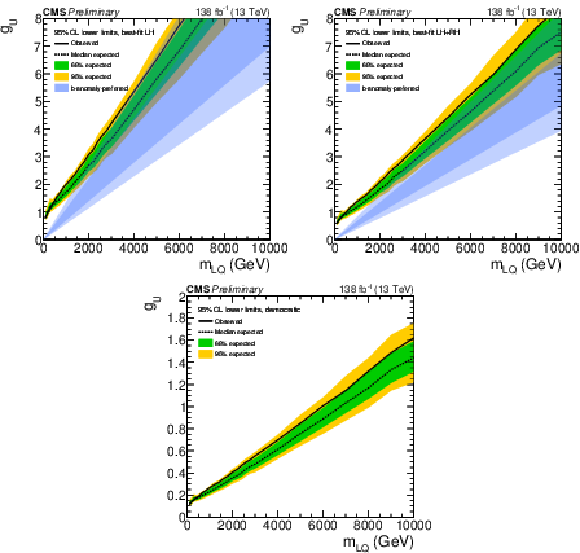
png pdf |
Figure 10:
Expected and observed lower limits of the LQ mass as a function of the coupling gU in the LH (left), LH+RH (right), and democratic (lower) scenarios. The blue band shows the 68% and 95% regions of gU preferred by the fit to the b-anomaly data [47]. |
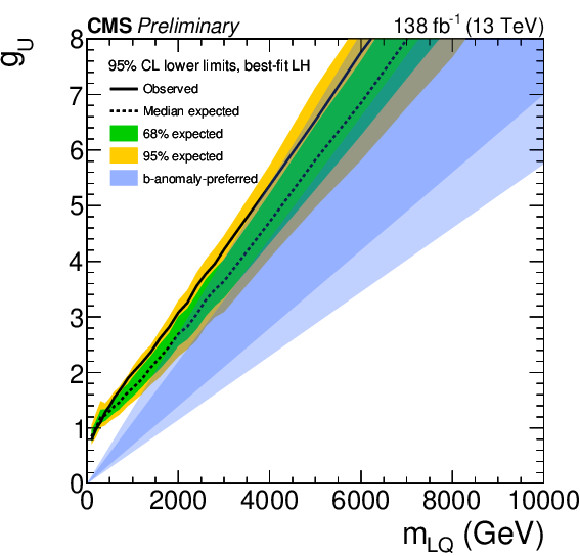
png pdf |
Figure 10-a:
Expected and observed lower limits of the LQ mass as a function of the coupling gU in the LH (left), LH+RH (right), and democratic (lower) scenarios. The blue band shows the 68% and 95% regions of gU preferred by the fit to the b-anomaly data [47]. |
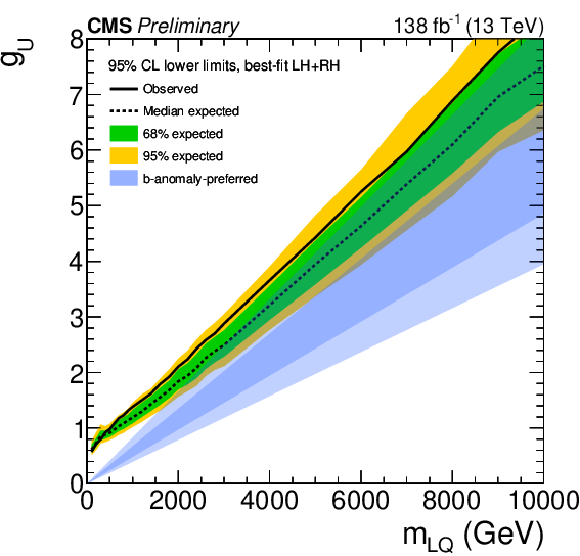
png pdf |
Figure 10-b:
Expected and observed lower limits of the LQ mass as a function of the coupling gU in the LH (left), LH+RH (right), and democratic (lower) scenarios. The blue band shows the 68% and 95% regions of gU preferred by the fit to the b-anomaly data [47]. |
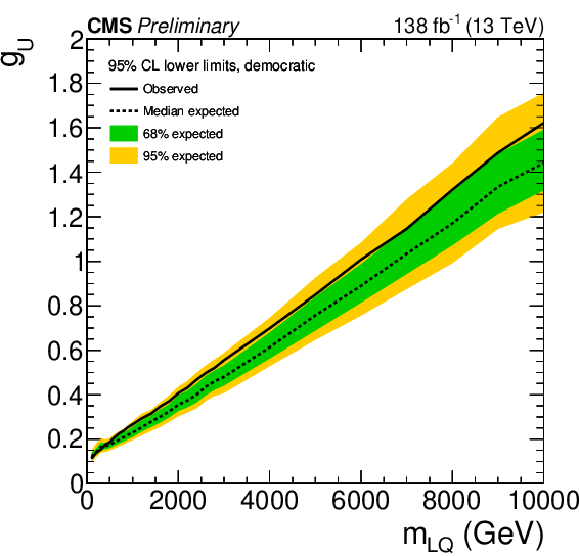
png pdf |
Figure 10-c:
Expected and observed lower limits of the LQ mass as a function of the coupling gU in the LH (left), LH+RH (right), and democratic (lower) scenarios. The blue band shows the 68% and 95% regions of gU preferred by the fit to the b-anomaly data [47]. |
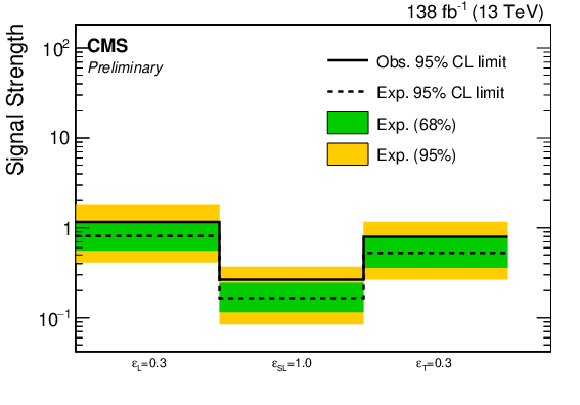
png pdf |
Figure 11:
Bayesian upper exclusion limits at 95% CL on the product of cross section and branching fraction of W' boson decays that have been modified by the Wilson coefficients described in Section 3. These limits are interpreted as exclusion limits on the signal strength of each of the Wilson coefficients described by the EFT model based on the combined Run-2 data collected by CMS. The three Wilson coefficients represent a left-handed vector coupling (ϵcbL), tensor-like coupling (ϵcbT), and scalar-tensor-like coupling (ϵcbSL). The 68 and 95% quantiles of the limits are represented by the green and yellow bands, respectively. |
| Tables | |
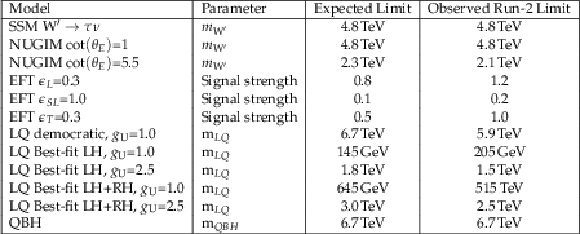
png pdf |
Table 1:
Summary of exclusion limits (expected and observed) calculated at 95% for full Run-2 CMS data for the physics models studied in this analysis: sequential standard model (SSM), nonuniversal gauge interaction model (NUGIM), an effectiv field interpretation (EFT), t-channel leptoquark (LQ) and quantum black hole (QBH) interpretation. |
| Summary |
|
A search for new resonant phenomena in the transverse mass, mT, distribution of the hadronically decaying τ lepton and missing transverse momentum, pTmiss, final state has been performed. The analysis uses Run-2 (2016-2018) data collected by the CMS detector in proton-proton collisions with √s= 13 TeV at the CERN LHC, corresponding to an integrated luminosity of 138 fb−1. The newly developed DeepTau ID is used to identify τ lepton candidates and separate signal from background. Background from jets being misidentified as hadronically decaying τ lepton candidates is derived from data. No significant deviation from the standard model expectations is observed. Upper limits are set on the product of the production cross section and branching ratio σB of a new resonance gauge (W') boson decaying to a τ lepton and pTmiss at 95% confidence level (CL). These limits are translated into lower exclusion limits on the sequential standard model W' boson mass and the mass of a quantum black hole. Upper limits are also set the σB and translated into upper exclusion limits on the ratio of the couplings to the W' boson to that of the coupling to the standard model W boson, gW′/gW, in the case of the generalised coupling model, the signal strength in the case of the Wilson coefficients in the EFT model, and the mixing angle cot(θE) for the nonuniversal gauge interaction model. The process of t-channel leptoquark exchange is targeted explicitly in this analysis. Upper limits are placed on the cross section of the pp→τν process mediated by t-channel LQ exchange for the first time. Three benchmark coupling scenarios are tested, which correspond to the best-fits to the flavor anomaly data and a generic democratic flavor structure. Significant portions of the LQ parameter space are excluded by placing lower limits on the LQ mass as a function of the LQ coupling gU, including parts of the region preferred (at the 95% CL) by a vector LQ explanation of the anomalies. |
| References | ||||
| 1 | R. N. Mohapatra and J. C. Pati | "natural" left-right symmetry | PRD 11 (May, 1975) 2558 | |
| 2 | R. N. Mohapatra and J. C. Pati | Left-right gauge symmetry and an "isoconjugate" model of CP violation | PRD 11 (Feb, 1975) 566 | |
| 3 | G. Altarelli, B. Mele, and M. Ruiz-Altaba | Searching for New Heavy Vector Bosons in pˉp Colliders | Z. Phys. C 45 (1989) 109 | |
| 4 | CMS Collaboration | Search for W' decaying to tau lepton and neutrino in proton-proton collisions at √s= 8 TeV | PLB 755 (2016) 196 | CMS-EXO-12-011 1508.04308 |
| 5 | A. M. Sirunyan et al. | Search for a W' boson decaying to a τ lepton and a neutrino in proton-proton collisions at √s= 13 TeV | Physics Letters B 792 (May, 2019) 107--131 | |
| 6 | ATLAS Collaboration | Search for high-mass resonances decaying to τν in pp collisions at √s= 13 TeV with the ATLAS detector | PRL 120 (2018) 161802 | 1801.06992 |
| 7 | C.-W. Chiang, N. G. Deshpande, X.-G. He, and J. Jiang | The family SU(2)lx SU(2)hxU(1) model | PRD 81 (2010) 015006 | 0911.1480 |
| 8 | Y. G. Kim and K. Y. Lee | Early LHC bound on the W' boson mass in the nonuniversal gauge interaction model | PLB 706 (2012) 367 | 1105.2653 |
| 9 | L. Edelhauser and A. Knochel | Observing nonstandard W' and Z' through the third generation and Higgs lens | 2014 | 1408.0914 |
| 10 | BaBar Collaboration | Evidence for an excess of ˉB→D(∗)τ−ˉντ decays | PRL 109 (2012) 101802 | 1205.5442 |
| 11 | BaBar Collaboration | Measurement of an Excess of ˉB→D(∗)τ−ˉντ Decays and Implications for Charged Higgs Bosons | PRD88 (2013), no. 7, 072012 | 1303.0571 |
| 12 | Belle Collaboration | Measurement of the branching ratio of ˉB→D(∗)τ−ˉντ relative to ˉB→D(∗)ℓ−ˉνℓ decays with hadronic tagging at Belle | PRD 92 (2015), no. 7, 072014 | 1507.03233 |
| 13 | Belle Collaboration | Measurement of the τ lepton polarization and R(D∗) in the decay ˉB→D∗τ−ˉντ | PRL 118 (2017), no. 21, 211801 | 1612.00529 |
| 14 | Belle Collaboration | Measurement of the τ lepton polarization and R(D∗) in the decay ˉB→D∗τ−ˉντ with one-prong hadronic τ decays at Belle | PRD 97 (2018), no. 1, 012004 | 1709.00129 |
| 15 | Belle Collaboration | Measurement of R(D) and R(D∗) with a semileptonic tagging method | PRL 124 (2020), no. 16, 161803 | 1910.05864 |
| 16 | LHCb Collaboration | Measurement of the ratio of branching fractions B(ˉB0→D∗+τ−ˉντ)/B(ˉB0→D∗+μ−ˉνμ) | PRL 115 (2015), no. 11, 111803 | 1506.08614 |
| 17 | LHCb Collaboration | Measurement of the ratio of the B0→D∗−τ+ντ and B0→D∗−μ+νμ branching fractions using three-prong τ-lepton decays | PRL 120 (2018), no. 17, 171802 | 1708.08856 |
| 18 | LHCb Collaboration | Test of Lepton Flavor Universality by the measurement of the B0→D∗−τ+ντ branching fraction using three-prong τ decays | PRD97 (2018), no. 7, 072013 | 1711.02505 |
| 19 | Belle Collaboration | Test of Lepton-Flavor Universality in B→K∗ℓ+ℓ− Decays at Belle | PRL 126 (2021), no. 16, 161801 | 1904.02440 |
| 20 | Belle Collaboration | Test of lepton flavor universality and search for lepton flavor violation in B→Kℓℓ decays | JHEP 03 (2021) 105 | 1908.01848 |
| 21 | LHCb Collaboration | Search for lepton-universality violation in B+→K+ℓ+ℓ− decays | PRL 122 (2019), no. 19, 191801 | 1903.09252 |
| 22 | LHCb Collaboration | Test of lepton universality with B0→K∗0ℓ+ℓ− decays | JHEP 08 (2017) 055 | 1705.05802 |
| 23 | LHCb Collaboration | Test of lepton universality in beauty-quark decays | NP 18 (2022), no. 3, 277--282 | 2103.11769 |
| 24 | LHCb Collaboration | Tests of lepton universality using B0→K0Sℓ+ℓ− and B+→K∗+ℓ+ℓ− decays | PRL 128 (2022), no. 19, 191802 | 2110.09501 |
| 25 | M. Tanaka and R. Watanabe | New physics in the weak interaction of ˉB→D(∗)τˉν | PRD 87 (2013) 034028 | 1212.1878 |
| 26 | Y. Sakaki, M. Tanaka, A. Tayduganov, and R. Watanabe | Testing leptoquark models in ˉB→D(∗)τˉν | PRD 88 (2013) 094012 | 1309.0301 |
| 27 | I. Doršner, S. Fajfer, N. Košnik, and I. Nišandžić | Minimally flavored colored scalar in ˉB→D(∗)τˉν and the mass matrices constraints | JHEP 11 (2013) 084 | 1306.6493 |
| 28 | B. Dumont, K. Nishiwaki, and R. Watanabe | LHC constraints and prospects for S1 scalar leptoquark explaining the ˉB→D(∗)τˉν anomaly | PRD 94 (2016) 034001 | 1603.05248 |
| 29 | I. Doršner, S. Fajfer, D. A. Faroughy, and N. Košnik | The role of the S3 GUT leptoquark in flavor universality and collider searches | JHEP 10 (2017) 188 | 1706.07779 |
| 30 | D. Bečirević et al. | Scalar leptoquarks from grand unified theories to accommodate the B-physics anomalies | PRD 98 (2018), no. 5, 055003 | 1806.05689 |
| 31 | A. Crivellin, D. Müller, and T. Ota | Simultaneous explanation of R(D(∗)) and b→sμ+μ−: the last scalar leptoquarks standing | JHEP 09 (2017) 040 | 1703.09226 |
| 32 | B. Gripaios, M. Nardecchia, and S. A. Renner | Composite leptoquarks and anomalies in B-meson decays | JHEP 05 (2015) 006 | 1412.1791 |
| 33 | M. Bauer and M. Neubert | Minimal leptoquark explanation for the RD(∗), RK , and (g−2)μ anomalies | PRL 116 (2016) 141802 | 1511.01900 |
| 34 | E. Coluccio Leskow, G. DAmbrosio, A. Crivellin, and D. Muller | (g−2)μ, lepton flavor violation, and Z decays with leptoquarks: Correlations and future prospects | PRD 95 (2017) 055018 | 1612.06858 |
| 35 | D. Bečirević and O. Sumensari | A leptoquark model to accommodate RexpK<RSMK and RexpK∗<RSMK∗ | JHEP 08 (2017) 104 | 1704.05835 |
| 36 | G. Hiller and I. Nišandžić | RK and RK∗ beyond the standard model | PRD 96 (2017) 035003 | 1704.05444 |
| 37 | G. Hiller, D. Loose, and I. Nišandžić | Flavorful leptoquarks at hadron colliders | PRD 97 (2018) 075004 | 1801.09399 |
| 38 | L. Di Luzio, A. Greljo, and M. Nardecchia | Gauge leptoquark as the origin of B-physics anomalies | PRD 96 (2017), no. 11, 115011 | 1708.08450 |
| 39 | L. Di Luzio et al. | Maximal Flavour Violation: a Cabibbo mechanism for leptoquarks | JHEP 11 (2018) 081 | 1808.00942 |
| 40 | L. Calibbi, A. Crivellin, and T. Li | Model of vector leptoquarks in view of the B-physics anomalies | PRD 98 (2018), no. 11, 115002 | 1709.00692 |
| 41 | M. Bordone, C. Cornella, J. Fuentes-Martin, and G. Isidori | A three-site gauge model for flavor hierarchies and flavor anomalies | PLB 779 (2018) 317 | 1712.01368 |
| 42 | R. Barbieri and A. Tesi | B-decay anomalies in Pati-Salam SU(4) | EPJC 78 (2018), no. 3, 193 | 1712.06844 |
| 43 | D. Buttazzo, A. Greljo, G. Isidori, and D. Marzocca | B-physics anomalies: a guide to combined explanations | JHEP 11 (2017) 044 | 1706.07808 |
| 44 | D. Marzocca | Addressing the B-physics anomalies in a fundamental Composite Higgs Model | JHEP 07 (2018) 121 | 1803.10972 |
| 45 | M. J. Baker, J. Fuentes-Martín, G. Isidori, and M. Konig | High- pT signatures in vector-leptoquark models | EPJC 79 (2019), no. 4, 334 | 1901.10480 |
| 46 | C. Cornella, J. Fuentes-Martin, and G. Isidori | Revisiting the vector leptoquark explanation of the B-physics anomalies | JHEP 07 (2019) 168 | 1903.11517 |
| 47 | C. Cornella et al. | Reading the footprints of the B-meson flavor anomalies | JHEP 08 (2021) 050 | 2103.16558 |
| 48 | CMS Collaboration | Constraints on models of scalar and vector leptoquarks decaying to a quark and a neutrino at √s= 13 TeV | PRD 98 (2018), no. 3, 032005 | CMS-SUS-18-001 1805.10228 |
| 49 | ATLAS Collaboration | Search for a scalar partner of the top quark in the all-hadronic tˉt plus missing transverse momentum final state at √s= 13 TeV with the ATLAS detector | EPJC 80 (2020), no. 8, 737 | 2004.14060 |
| 50 | ATLAS Collaboration | Search for new phenomena in final states with B-jets and missing transverse momentum in √s= 13 TeV pp collisions with the ATLAS detector | JHEP 05 (2021) 093 | 2101.12527 |
| 51 | CMS Collaboration | Search for singly and pair-produced leptoquarks coupling to third-generation fermions in proton-proton collisions at √s= 13 TeV | PLB 819 (2021) 136446 | CMS-EXO-19-015 2012.04178 |
| 52 | ATLAS Collaboration | Search for pair production of scalar leptoquarks decaying into first- or second-generation leptons and top quarks in proton-proton collisions at √s= 13 TeV with the ATLAS detector | EPJC 81 (2021), no. 4, 313 | 2010.02098 |
| 53 | CMS Collaboration | Search for leptoquarks coupled to third-generation quarks in proton-proton collisions at √s= 13 TeV | PRL 121 (2018), no. 24, 241802 | CMS-B2G-16-027 1809.05558 |
| 54 | ATLAS Collaboration | Search for pair production of third-generation scalar leptoquarks decaying into a top quark and a τ-lepton in pp collisions at √s= 13 TeV with the ATLAS detector | JHEP 06 (2021) 179 | 2101.11582 |
| 55 | CMS Collaboration | Search for third-generation scalar leptoquarks decaying to a top quark and a τ lepton at √s= 13 TeV | EPJC 78 (2018) 707 | CMS-B2G-16-028 1803.02864 |
| 56 | ATLAS Collaboration | Search for new phenomena in pp collisions in final states with tau leptons, b-jets, and missing transverse momentum with the ATLAS detector | PRD 104 (2021), no. 11, 112005 | 2108.07665 |
| 57 | CMS Collaboration | Search for heavy neutrinos and third-generation leptoquarks in hadronic states of two τ leptons and two jets in proton-proton collisions at √s= 13 TeV | JHEP 03 (2019) 170 | CMS-EXO-17-016 1811.00806 |
| 58 | CMS Collaboration | Search for a singly produced third-generation scalar leptoquark decaying to a τ lepton and a bottom quark in proton-proton collisions at √s= 13 TeV | JHEP 07 (2018) 115 | CMS-EXO-17-029 1806.03472 |
| 59 | L. Di Luzio and M. Nardecchia | What is the scale of new physics behind the B-flavour anomalies? | EPJC 77 (2017), no. 8, 536 | 1706.01868 |
| 60 | A. Greljo, J. Martin Camalich, and J. D. Ruiz-\'Alvarez | Mono-τ Signatures at the LHC Constrain Explanations of B-decay Anomalies | PRL 122 (2019), no. 13, 131803 | 1811.07920 |
| 61 | D. M. Gingrich | Quantum black holes with charge, colour, and spin at the LHC | JPG37 (2010) 105008 | 0912.0826 |
| 62 | CMS Collaboration | CMS technical design report for the pixel detector upgrade | CDS | |
| 63 | CMS Collaboration | Performance of the CMS Level-1 trigger in proton-proton collisions at √s= 13 TeV | JINST 15 (2020) P10017 | CMS-TRG-17-001 2006.10165 |
| 64 | CMS Collaboration | The CMS trigger system | JINST 12 (2017) P01020 | CMS-TRG-12-001 1609.02366 |
| 65 | CMS Collaboration | The CMS experiment at the CERN LHC | JINST 3 (2008) S08004 | CMS-00-001 |
| 66 | K. Thorne | Nonspherical Gravitational Collapse–A Short Review | Klauder, John R., 2012 | |
| 67 | N. Arkani-Hamed, S. Dimopoulos, and G. Dvali | The hierarchy problem and new dimensions at a millimeter | Physics Letters B 429 (Jun, 1998) 263--272 | |
| 68 | W. Buchmüller, R. Rückl, and D. Wyler | Leptoquarks in Lepton - Quark Collisions | PLB 191 (1987) 442 | |
| 69 | CMS Collaboration | Precision luminosity measurement in proton-proton collisions at √s= 13 TeV in 2015 and 2016 at CMS | EPJC 81 (2021), no. 9, 800 | CMS-LUM-17-003 2104.01927 |
| 70 | CMS Collaboration | CMS luminosity measurement for the 2017 data-taking period at √s= 13 TeV | CMS-PAS-LUM-17-004 | CMS-PAS-LUM-17-004 |
| 71 | CMS Collaboration | CMS luminosity measurement for the 2018 data-taking period at √s= 13 TeV | CMS-PAS-LUM-18-002 | CMS-PAS-LUM-18-002 |
| 72 | T. Sjostrand et al. | An introduction to PYTHIA 8.2 | Comp. Phys. Comm. 191 (2015) 159 | 1410.3012 |
| 73 | NNPDF Collaboration | Parton distributions from high-precision collider data | EPJC 77 (2017), no. 10, 663 | 1706.00428 |
| 74 | R. D. Ball et al. | Parton distributions with LHC data | NPB 867 (2013) 244 | 1207.1303 |
| 75 | S. Agostinelli et al. | GEANT4--a simulation toolkit | NIMA 506 (2003) 250 | |
| 76 | J. Alwall et al. | MadGraph 5: going beyond | JHEP 06 (2011) 128 | 1106.0522 |
| 77 | J. Alwall et al. | The automated computation of tree-level and next-to-leading order differential cross sections, and their matching to parton shower simulations | JHEP 07 (2014) 079 | 1405.0301 |
| 78 | P. Skands, S. Carrazza, and J. Rojo | Tuning PYTHIA 8.1: the Monash 2013 Tune | EPJC 74 (2014), no. 8 | 1404.5630 |
| 79 | CMS Collaboration | Extraction and validation of a new set of CMS PYTHIA8 tunes from underlying-event measurements | EPJC 80 (2020) 4 | CMS-GEN-17-001 1903.12179 |
| 80 | CMS Collaboration | Particle-flow reconstruction and global event description with the CMS detector. | JINST 12 (Jun, 2017) P10003. 82 p | CMS-PRF-14-001 1706.04965 |
| 81 | M. Cacciari, G. P. Salam, and G. Soyez | The anti-kt jet clustering algorithm | JHEP 04 (2008) 063 | 0802.1189 |
| 82 | M. Cacciari, G. P. Salam, and G. Soyez | FastJet user manual | EPJC 72 (2012) 1896 | 1111.6097 |
| 83 | CMS Collaboration | Jet energy scale and resolution in the CMS experiment in pp collisions at 8 TeV | JINST 12 (2017) P02014 | CMS-JME-13-004 1607.03663 |
| 84 | CMS Collaboration | Performance of missing transverse momentum reconstruction in proton-proton collisions at √s= 13 TeV using the CMS detector | JINST 14 (2019) P07004 | CMS-JME-17-001 1903.06078 |
| 85 | CMS Collaboration | Reconstruction and identification of τ lepton decays to hadrons and ντ at CMS. | JINST 11 (Oct, 2015) P01019. 72 p | |
| 86 | CMS Collaboration | Identification of hadronic tau lepton decays using a deep neural network | CMS-TAU-20-001 2201.08458 |
|
| 87 | P. Nason | A New method for combining NLO QCD with shower Monte Carlo algorithms | JHEP 11 (2004) 040 | hep-ph/0409146 |
| 88 | S. Frixione, P. Nason, and C. Oleari | Matching NLO QCD computations with Parton Shower simulations: the POWHEG method | JHEP 11 (2007) 070 | 0709.2092 |
| 89 | S. Alioli, P. Nason, C. Oleari, and E. Re | A general framework for implementing NLO calculations in shower Monte Carlo programs: the POWHEG BOX | JHEP 06 (2010) 043 | 1002.2581 |
| 90 | A. Buckley et al. | LHAPDF6: parton density access in the LHC precision era | EPJC 75 (2015) 132 | 1412.7420 |
| 91 | G. Balossini et al. | Combination of electroweak and QCD corrections to single W production at the Fermilab Tevatron and the CERN LHC | JHEP 01 (2010) 013 | 0907.0276 |
| 92 | J. R. Andersen et al. | Les Houches 2013: Physics at TeV colliders: Standard model working group report | 2014 | 1405.1067 |
| 93 | A. Arbuzov et al. | Update of the MCSANC Monte Carlo integrator, v. 1.20 | JEPTL 103 (2016), no. 2, 131--136 | 1509.03052 |
| 94 | S. G. Bondarenko and A. A. Sapronov | NLO EW and QCD proton-proton cross section calculations with mcsanc-v1.01 | CPC 184 (2013) 2343--2350 | 1301.3687 |
| 95 | CMS Collaboration | CMS Luminosity Measurements for the 2016 Data Taking Period | CMS-PAS-LUM-17-001 | CMS-PAS-LUM-17-001 |
| 96 | J. Butterworth et al. | PDF4LHC recommendations for LHC Run II | JPG 43 (2016) 023001 | 1510.03865 |
| 97 | A. Accardi et al. | A Critical Appraisal and Evaluation of Modern PDFs | EPJC 76 (2016), no. 8, 471 | 1603.08906 |
| 98 | P. Zyla et al. | Review of particle physics | Prog. Theor. Exp. Phys. 2020 (2020) O83C01 | |
| 99 | The ATLAS Collaboration, The CMS Collaboration, The LHC Higgs Combination Group | Procedure for the LHC Higgs boson search combination in Summer 2011 | CMS-NOTE-2011-005 | |
| 100 | L. Moneta et al. | The RooStats prject | in 13th International Workshop on Advanced Computing and Analysis Techniques in Physics Research (ACAT2010), volume PoS(ACAT2010) 2010 | hep-ph/1009.1003v2 |
| 101 | R. Alonso, A. Kobach, and J. Martin Camalich | New physics in the kinematic distributions of ˉB→D(∗)τ−(→ℓ−ˉνℓντ)ˉντ | PRD 94 (2016), no. 9, 094021 | 1602.07671 |

|
Compact Muon Solenoid LHC, CERN |

|

|

|

|

|

|